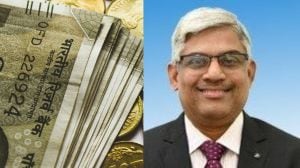Before jail death,2 murders and a scam that claimed 2 ministers
The events leading to the arrest of Dy CMO Y S Sachan,who died in Lucknow jail.
The death of Dr Y S Sachan in Lucknow jail on Wednesday night has brought the spotlight back on alleged corruption in the health department,the presence of criminal elements in the business of government supplies and their political patrons.
Dr Sachan had been arrested on charges of hiring the killers of Dr B P Singh,Lucknows deputy Chief Medical Officer (family welfare),who was gunned down by two motorcycle riders when taking a morning walk on April 2. On October 27 last year,Dr Singhs predecessor,Dr Vinod Arya,too had been killed in identical fashion.
Dr Sachan,deputy CMO,had officiated as CMO in the period after Dr Aryas murder and before Dr Singh took over. The government says that Dr Singh,after taking over,detected irregularities in the purchase of drugs and warned Dr Sachan to be ready to face an inquiry. Dr Sachan then decided to have Dr Singh killed and hired two hitmen through a friend,the government said last week. The government claimed Dr Sachan had a link with Dr Aryas murder too,but never came out with a motive.
But a link there definitely was between the murders. Forensic examination of the empties found at the spot of Dr Singhs murder revealed that some of these bullets had been fired from one of the weapons used in the shooting of Dr Arya.
Among government doctors and in political circles,the two murders were regarded as the handiwork of politically connected criminals who,through front men,operate in the business of making government supplies. It is believed the two doctors paid for doing,or not doing,something these men wanted.
DEPARTMENTAL DIVIDE
The murky story begins in May 2010 when the government posted CMOs under the family welfare department in districts for implementation of National Rural Health Mission programmes.
Until then,NRHM had been the responsibility of CMOs (Health),since a large part of the implementing machinery was under the control of the health department. The new system in UP was the only one of its kind in the entire country. It was introduced purportedly to improve implementation of NRHM programmes,but the common belief among government doctors was that the real objective was to benefit powerful political interests who had their eyes on the money flowing in. The Provincial Medical Services Association,the union of government doctors,opposed the division,saying it was illegal and irrational and diluted the authority of the CMO (Health).
K Sujatha Rao,then health and family welfare secretary at the Centre,wrote to Uttar Pradesh Chief Secretary Atul Gupta in July 2010 that the bifurcation will not be in the interest of the implementation of NRHM and goes against the basic principles that it (the Union ministry) has advocated for better results in the health sector. She asked the state to re-examine the decision,but the latter was determined.
The portoflio of family welfare,until then held by the Chief Minister,was given to Babu Singh Kushwaha,who also held other potentially money-spinning departments like mines and minerals and co-operatives. Kushwaha was also the BSP general secretary and one of Chief Minister Mayawatis most trusted ministers. Health Minister Anant Mishra had no role in the NRHM.
As apprehended,the new system created confusion. Districts saw fights between the two CMOs over staff,vehicles,furniture and office space. There were fights over who should check the spread of dengue and swine flu. Since the CMOs (Health) had their own priorities,work on most NRHM programmes suffered.
In several districts,junior doctors were handpicked and posted as CMOs (Family Welfare).
EQUATIONS UPSET
Many were happy with the new system,but it also hurt those who could not board the gravy train. Among them were certain suppliers,many of them linked to mafia dons who,in turn,had political godfathers. In the department,they had officers and doctors ready to do their bidding to make extra money. Besides,they took cuts from others for getting them orders. The new arrangement upset old equations. Many of these suppliers also had rivalries with one another.
It is believed that the two CMOs were killed when one or more of such dons,or their men,felt they were not having their way. Doctors point out that B P Singh was shot dead immediately after the close of the financial year. Apparently,whoever ordered the killing had hoped for something happening by March 31 but it did not.
The back-to-back murders led to a surge of protests and the demand for a CBI inquiry. As part of the investigation,the government ordered a scan of supply orders and payments. In the words of cabinet secretary Shashank Shekhar Singh,the investigation threw up instances of serious financial irregularities,payments against fake bills and embezzlement.
SHAKE-UP
Ministers Kushwaha and Mishra were asked to resign,owning moral responsibility for the irregularities. The government also abolished the system of parallel CMOs of family welfare and went back to the old system.
Dr Sachan and some others were arrested for financial irregularities. A criminal case was also registered against Dr A K Shukla,CMO (Health) in Lucknow,for an alleged role in the financial irregularities before the separation of family welfare from health.
But these actions failed to impress those who had demanded action. Opposition leaders alleged that the state government was trying to divert attention from the two murders,create an impression that it was out to curb corruption,scare doctors not to be hyperactive,and pre-empt a CBI inquiry.
The naming of Dr Sachan last week as the man behind the murder of at least one of the two CMOs,with his name linked to the other murder,was seen as the next step towards ensuring a safe burial of the controversy. His death has foiled the game-plan.



- 01
- 02
- 03
- 04
- 05




























